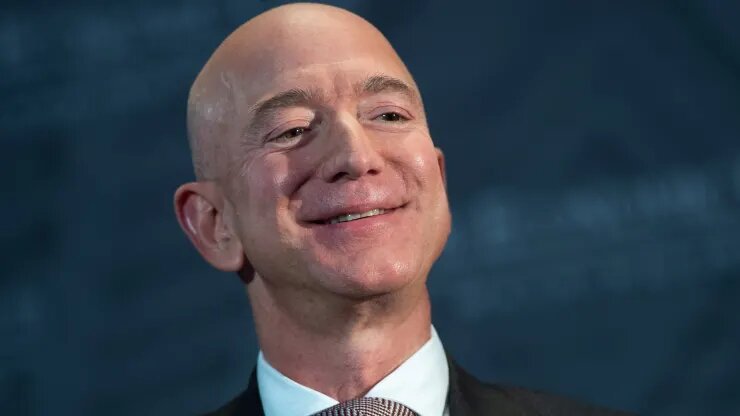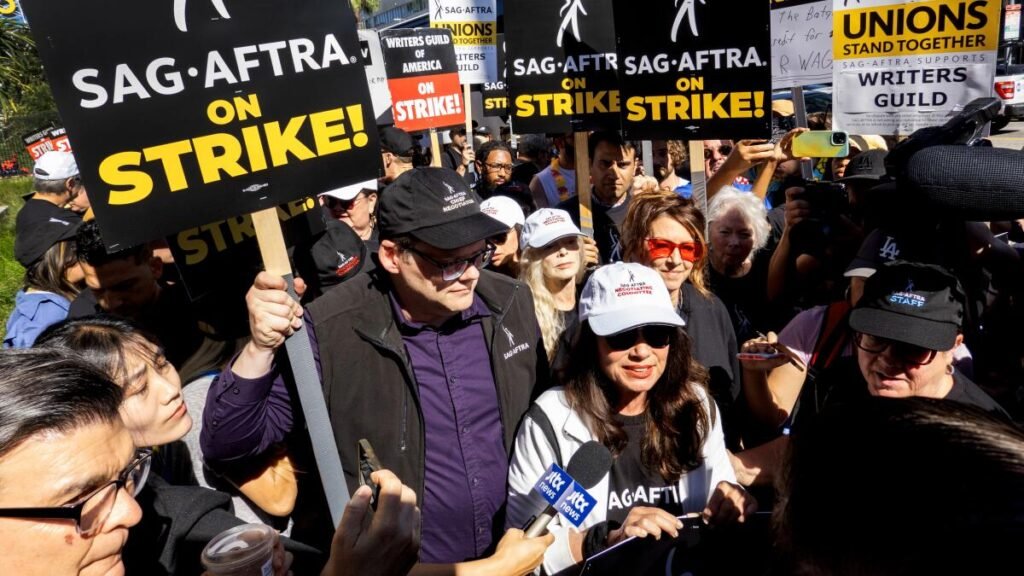Business
Elon Musk Is Briefly Overtaken by Jeff Bezos as the Richest Person in the United States
Published
1 year agoon

According to real-time data, Amazon CEO Jeff Bezos regained his position as the richest person in the world after surpassing Tesla CEO Elon Musk.
Due to the fact, that Tesla shares finished at $796.22 on Tuesday, down more than 2.4%, Musk suffered a $3.9 billion decline in his net worth. The 49-year-old businessman overtook Bezos in January to take the title of the world’s richest person thanks to Tesla’s soaring share price and his substantial salary.
As fast as Musk moved up the ranks, he handed Bezos back the title of richest person in the world. Bezos has been the richest man since 2017 until this month.
Along with the company’s share price, the founder of Amazon has seen a sharp increase in personal fortune in recent years. This wealth is primarily comprised of Amazon stock. Bezos has persisted in reaching new financial benchmarks. He was the first to see his net worth soar past $200 billion in August of last year, and when his wealth surpassed $150 billion in 2018, he became the richest man in modern history.
As he gets ready to resign from his position later this year, Bezos once again rose to the top of the global richest list. Bezos declared earlier this month that he will hand the reins to Andy Jassy, Amazon’s chief cloud executive.
Bezos is anticipated to continue monitoring the business he created, but he will have more time to concentrate on other endeavors, such as The Washington Post and his rocket company Blue Origin, in addition to his charitable endeavors, the Bezos Earth Fund and the Amazon Day 1 Fund.
Sahil Sachdeva is the CEO of Level Up Holdings, a Personal Branding agency. He creates elite personal brands through social media growth and top tier press features.

You may like

In the heart of the oilfields, a quiet revolution is underway. For decades, the oil and gas industry has grappled with the challenge of managing vast quantities of wastewater, a byproduct of extraction processes. Traditionally viewed as a costly nuisance, this “produced water” is now being reconsidered—not as waste, but as a potential resource. This paradigm shift is driving innovative strategies aimed at transforming wastewater management, turning environmental liabilities into economic assets.
The Scale of the Challenge
Every barrel of oil extracted brings with it several barrels of produced water. This wastewater contains a complex mix of hydrocarbons, salts, and other contaminants, making its treatment and disposal a significant operational concern. Historically, the industry has relied on methods like deep well injection to manage this waste. However, growing environmental concerns, regulatory pressures, and the high costs associated with traditional disposal methods have prompted a reevaluation of wastewater management practices.
Turning Waste into Resource
The industry’s new approach focuses on the treatment and reuse of produced water. By employing advanced technologies, companies aim to recycle this water for various applications, thereby reducing the demand for freshwater and minimizing environmental impact.

Advanced Treatment Technologies
Innovations in water treatment are central to this transformation. Techniques such as low-temperature evaporation crystallization have emerged as effective methods for treating high-salinity wastewater. This process not only purifies the water but also facilitates the recovery of valuable minerals, contributing to both environmental sustainability and economic viability.
Strategic Reuse Initiatives
Beyond treatment, strategic reuse of treated wastewater is gaining traction. In regions like New Mexico, where water scarcity is a pressing issue, treated produced water is being considered for agricultural and industrial applications. Pilot programs are exploring the feasibility of using this water for irrigation and as a resource in industrial processes, offering a sustainable solution to water shortages.
Economic and Environmental Implications
The shift towards wastewater reuse carries significant economic and environmental implications. Economically, it presents an opportunity to reduce operational costs associated with water procurement and waste disposal. Environmentally, it aligns with broader sustainability goals by conserving freshwater resources and reducing the ecological footprint of oil and gas operations.
Moreover, the potential to extract valuable minerals from treated wastewater adds an additional economic incentive. Elements like lithium, essential for battery production, can be recovered during the treatment process, opening new revenue streams for the industry.
Regulatory and Community Engagement
Implementing these innovative wastewater management strategies requires navigating complex regulatory landscapes and engaging with local communities. Regulatory frameworks are evolving to accommodate new treatment and reuse practices, ensuring that environmental and public health standards are maintained.
Community engagement is equally critical. Transparent communication about the benefits and safety of wastewater reuse initiatives fosters public trust and supports the successful integration of these practices into local water management strategies.
The Road Ahead
The oil and gas industry’s efforts to transform wastewater management reflect a broader commitment to innovation and sustainability. By reimagining produced water as a resource rather than a waste product, the industry is not only addressing environmental challenges but also unlocking new economic opportunities.
As these initiatives continue to develop, collaboration among industry stakeholders, regulators, and communities will be essential. Together, they can drive the adoption of sustainable wastewater management practices, contributing to a more resilient and environmentally responsible energy sector.
Level Up Insight:
The oil and gas industry’s innovative approach to wastewater management exemplifies how environmental challenges can be transformed into opportunities. By leveraging advanced technologies and strategic reuse initiatives, the industry is turning a longstanding problem into a solution that benefits both the environment and the economy. This evolution underscores the importance of adaptability and innovation in addressing complex sustainability issues.
Business
Trading Spike Before Trump Sons’ Appointments Raises Eyebrows
Published
4 days agoon
April 18, 2025
It was a quiet Tuesday on Wall Street until two small-cap stocks suddenly spiked. Nothing about the broader market hinted at a rally. There was no earnings call, no acquisition news, no press release. But still, shares of these otherwise overlooked companies surged. Forty-eight hours later, the announcement came: Donald Trump Jr. and Eric Trump were joining their advisory boards. That’s when the whispers started.
For the seasoned market watchers, the sudden surge in volume and price rang a familiar bell one that often tolls in the wake of insider trading allegations. These companies weren’t household names. But the last name suddenly attached to them Trump turned them into headline bait.
Let’s rewind and break this down.
The Trades Before the Trump News
In the days immediately preceding the public announcements, the trading activity around these two companies, let’s call them Company A and Company B for clarity, saw noticeable upticks. Stock prices jumped as much as 30% in unusually high volumes. On paper, it looked like a case of bullish sentiment. In practice, it felt too timely.
When the news dropped that Donald Trump Jr. and Eric Trump would be joining these companies’ advisory boards, the market’s reaction made more sense. Investors were betting on the Trump name drawing attention, capital, and potentially political clout. But the problem wasn’t the reaction to the news—it was how many investors seemed to anticipate it before it became public.
The Trump Brand: A Market Mover
Whether loved or loathed, the Trump brand has undeniable market value. Since the Trump presidency, companies even remotely tied to the name often experience dramatic market reactions. This latest example underscores how that dynamic can ripple beyond politics and into private markets.
But this time, it’s not just a matter of hype—it’s about timing. And when it comes to timing the market with nonpublic information, things get murky fast.
Analysts and financial watchdogs began to flag the trading activity as “unusual.” To the naked eye, it’s the kind of pattern that triggers internal reviews on trading desks and alerts at regulatory agencies like the SEC. The question floating above the trading floor was: Did someone know something before they were supposed to?

No Evidence Yet, But Questions Mount
Let’s be clear: there is no direct evidence, as of now, that Donald Trump Jr. or Eric Trump were involved in tipping off investors. No formal charges. No public investigation. But financial journalists, analysts, and political observers are asking the same question: who bought in, and how did they know?
If the pattern holds true with previous market manipulation cases, the SEC will likely take a closer look. Often, unusual trades trigger “blue sheet” requests—regulatory subpoenas that demand detailed records from brokers and financial firms. These can reveal the identities of traders and link them to insiders if a connection exists.
It’s also worth noting that this isn’t the first time Trump-related companies have experienced unexplained market shifts. From SPACs to social media ventures, the Trump name has become a kind of financial accelerant—one that can fuel both rallies and investigations.
The Optics of Influence
Beyond legality, there’s the question of optics. When former presidents’ children—especially those with their own media and political followings—get involved with public companies, it raises eyebrows. These are not just celebrity appointments. These are individuals with access to powerful networks and a legacy brand that can impact public sentiment and even policy direction.
Investors know that. So do company executives. That’s exactly why appointments like these are made in the first place. The Trump sons bring attention, legitimacy (for certain audiences), and the potential for press coverage that smaller companies can’t buy.
But with influence comes scrutiny. And in a political era already soaked in allegations of favoritism, backdoor deals, and blurred lines between public and private interests, this incident adds fuel to the fire.
The Timing Problem in Today’s Markets
Insider trading is notoriously hard to prove. Yet it remains one of the most damaging allegations for public trust in financial systems. In this case, even without clear wrongdoing, the optics of how everything unfolded have raised concerns about transparency and governance.
What we’re seeing is a symptom of a larger trend: when access becomes currency, and influence is traded like stock.
In 2025, markets move faster than ever. News spreads instantly. Stocks rise and fall in seconds based on sentiment. But the mechanics of insider advantage haven’t changed. Whether it’s a leak from a boardroom or a “tip” passed through private channels, the edge remains—only the methods evolve.
What Happens Next?
The SEC has yet to comment publicly, and the companies involved have issued standard press releases celebrating the high-profile appointments. For now, that’s where things stand. But under the surface, financial regulators, institutional investors, and political watchdogs are watching closely.
If a deeper connection is uncovered—if someone traded based on nonpublic information—it could spark a wave of hearings, headlines, and legal action. If not, it still sends a message about how fragile the boundary is between influence and impropriety in today’s financial ecosystem.
The Trump sons haven’t commented on the trading controversy, and their appointments appear to be proceeding as planned. But for investors, this incident serves as yet another reminder that markets aren’t always as free and fair as they appear.
Level Up Insight
In a market increasingly shaped by media clout and political gravity, the Trump brand remains a potent force. But when stock prices jump before the news hits the wire, it raises more than eyebrows—it invites scrutiny. Whether this case leads to concrete findings or quietly fades, it exposes the uneasy tension between influence, timing, and trust in the American financial system.
For founders, investors, and advisors navigating this new era: reputational risk is now part of your market cap. Transparency isn’t optional—it’s strategy. Because when the markets start whispering, regulators tend to listen.

Global tech’s delicate balance hangs precariously as a major island’s chips dominance becomes a flashpoint in the escalating economic tensions between two leading global powers. Both nations, despite their increasing economic divergence fueled by rising tariffs, share an undeniable and critical reliance: semiconductors produced by this key player. Navigating this intricate dependence is proving to be one of the most complex policy hurdles in their ongoing economic engagement.
Both leading economies view this island’s control over the world’s tech supply chain as a significant national security concern. Consequently, both have initiated efforts to bolster their own domestic chip manufacturing capabilities. However, as the sheer difficulty of replicating the sophisticated ecosystem built over decades by this island’s industry becomes starkly apparent, the two powers are adopting distinctly different strategies to manage their reliance on it and its leading chip manufacturer.
One major economy has recently launched a national security investigation into semiconductor imports, a move that could lead to the imposition of tariffs on the entire sector. A prominent domestic chip designer recently disclosed that it now requires government authorization to export advanced artificial intelligence chips to the other major economy. Public statements from its leadership have previously raised concerns about the island’s market position.
Conversely, the other major economy is taking a different approach. A recent directive from a state-backed trade organization there outlined exemptions for a significant portion of advanced chips from its tariffs on goods from the first major economy. Analysts suggest this move stems from a clear understanding of its critical need for these advanced components and a desire to prevent the ongoing economic engagement from hindering its access.
The result is that many cutting-edge chips, designed by companies in the first major economy but manufactured on the island, will not be subject to tariffs imposed by the second. While these chips might ultimately be acquired by companies in the first economy and then sold to entities in the second, for tariff purposes, the second economy will not consider these chips as originating from the first.
This marks a departure from conventional trade policy. Typically, the origin of a chip is determined by the location where the final stages of production, such as packaging, occur. However, the second major economy will now consider the location where the intricate circuits are etched onto the silicon wafers as the point of origin.
Much like its predecessor, the current leadership of the first major economy is actively trying to incentivize the island’s primary chip manufacturer and other foreign producers to establish more manufacturing facilities on its own soil. While previous approaches involved financial incentives, the current strategy includes the potential use of tariffs to encourage significant investment.
This diverging approach from the second major economy effectively presents a challenge to the long-standing efforts by multiple administrations in the first to revitalize its domestic chip manufacturing, according to a senior technology analyst at a prominent think tank. This is seen by some as a strategic maneuver with implications for tariff burdens and manufacturing locations.
A semiconductor research director at a leading analysis firm further noted that the second major economy’s strategy could also provide a competitive advantage to its own domestic chip manufacturers.
The production of advanced semiconductors is characterized by intricate and globally dispersed supply chains. Many electronics firms in the first major economy design the crucial chips for their devices but outsource the actual manufacturing to companies on the island. These manufacturers, in turn, procure essential materials like silicon wafers from nations such as Japan and specialized chemicals from the second major economy. The highly specialized machinery required for chip fabrication in Taiwan is often sourced from countries like the Netherlands. Subsequently, some of these chips are shipped to other nations, including Malaysia or the second major economy, for crucial testing before being integrated into consumer electronics or advanced computing systems assembled in places like Mexico or the second major economy.

The sourcing of materials is equally complex. Chemicals might undergo refinement in one country, be blended in a second, and finally be utilized in the production process in a third, as highlighted by a leading chip material consultant.
This intricate web of global dependencies makes the imposition of tariffs on the semiconductor industry a logistically daunting task, according to a director at a Taiwanese industry analysis firm. She emphasized that “chip making involves processing and reprocessing, assembly and reassembly, and layers of transportation.”
The vast majority of the world’s most advanced semiconductors are manufactured on this key island, where industry giants have invested billions of dollars over four decades to establish a sophisticated network of fabrication plants and supporting suppliers.
Analysts suggest that the second major economy’s decision to exempt chips made on the island is a clear acknowledgment of the profound reliance of its technology sector on this crucial manufacturing hub, despite previous concerns raised by the first major economy regarding the island’s market position.
The leading chip manufacturer on the island has not issued any official response to these developments.
The creation of a single semiconductor involves the participation of companies across numerous countries. As one major economy attempts to redefine the rules of international trade, each border crossing introduces the potential for tariffs, leading to a rapid accumulation of additional costs. The potential consequence of the ongoing tensions is a significant increase in the cost of chips and the consumer electronics that rely on them, according to industry experts.
“If the two largest economies in the world cannot come to an agreement, they will both drag each other down,” warned a chip material consultant. “Everyone is holding their breath.”
LevelUp Insight:
This intricate situation underscores a crucial reality in today’s interconnected world: even amidst significant economic tensions, technological dependencies can create unexpected alignments and strategic policy adjustments. The willingness of one major economy to make specific tariff exceptions highlights the indispensable nature of the other’s manufacturing capabilities in a critical sector. This isn’t solely about trade; it’s a clear demonstration of the deep integration of global supply chains, particularly within strategically important industries like semiconductors. For LevelUp readers, this emphasizes the delicate interplay between national economic strategies and international technological reliance, a key dynamic shaping the future of innovation and global economic power. Understanding these complex interdependencies is vital for navigating the evolving landscape of technology and international affairs.
Business
Cottagecore 2.0: The Return of Cozy, Nature-Inspired Living in 2025
Published
1 week agoon
April 14, 2025
Remember the Cottagecore trend that took over Instagram and TikTok a few years ago? Well, it’s back—but with a modern twist. Dubbed Cottagecore 2.0, this lifestyle movement is gaining momentum in 2025, with more people embracing rustic aesthetics, sustainable living, and cozy, handcrafted home décor. From celebrities to influencers, many are turning their homes into nature-inspired sanctuaries, blending vintage charm with contemporary comforts.
What is Cottagecore 2.0?
The original Cottagecore aesthetic celebrated a romanticized rural lifestyle—think floral dresses, vintage teacups, and hand-sewn quilts. However, the 2025 version of the trend incorporates:
- Smart Home Features in Rustic Spaces: Vintage aesthetics meet modern technology, with AI-powered fireplaces, automated greenhouses, and sustainable energy sources.
- Sustainable & Handmade Décor: More people are supporting local artisans and choosing upcycled, handcrafted furniture.
- Nature-Integrated Living: Urban dwellers are adding indoor gardens, hydroponic setups, and earthy color palettes to bring the outdoors in.
- DIY & Slow Living: From baking sourdough to knitting blankets, there’s a shift toward intentional, slower lifestyles.
Why is Cottagecore Trending Again?
- Escapism & Stress Relief: In today’s fast-paced digital world, people crave peaceful, nostalgic environments that allow them to slow down and disconnect. Cottagecore aesthetics offer that escape.
- Sustainability Movement: The growing focus on eco-friendly living has made rustic, upcycled décor and handmade goods more appealing than mass-produced alternatives.
- Social Media Influence: Platforms like TikTok and Instagram are flooded with home transformation videos showcasing cottage-style interiors, cozy reading nooks, and lush indoor gardens.
How to Embrace Cottagecore 2.0 in Your Home
-
Decorate with Earthy & Vintage Accents – Add rustic wooden furniture, floral wallpaper, antique mirrors, and cozy woven blankets.
- Bring Nature Indoors – Indoor plants, dried flowers, and herb gardens can instantly make a space feel warm and inviting.
- Embrace Handmade & DIY Projects – Try baking your own bread, learning embroidery, or upcycling thrifted furniture.
- Create a Cozy Reading Nook – A small corner with warm lighting, soft pillows, and bookshelves enhances the Cottagecore aesthetic.
Cottagecore 2.0 isn’t just about aesthetic trends—it’s a movement toward slower, mindful living in a world that often feels too fast. Whether it’s incorporating vintage décor or adopting a more self-sufficient lifestyle, this trend is shaping how people create cozy, meaningful spaces in 2025.
Business
SAG-AFTRA’s New Ad Deal Signals a Shift in Talent Rights
Published
1 week agoon
April 14, 2025
After months of negotiation and growing tension behind closed doors, SAG-AFTRA and the advertising industry’s top players have finally reached a tentative agreement. This successor deal, aimed at replacing the old contracts governing how union performers work in commercials, could shape the future of advertising talent across the U.S. With the commercial world leaning more digital, and actors demanding better pay, protections, and transparency, this agreement is not just a handshake—it’s a shift in how labor and brand storytelling will coexist moving forward.
In the last few years, a silent tug-of-war has been unfolding in the world of commercial advertising. Actors wanted more than a line in a script—they wanted a fair share of the value they bring to campaigns. As influencers blur the lines between creators and performers, and AI tools creep into talent spaces, the existing contracts had started to feel more like relics than roadmaps.
Now, with this tentative agreement in place, there’s cautious optimism from both sides.
For advertisers, this deal promises stability. For performers, it signals progress. And for the entertainment industry at large, it’s a rare moment of collaboration in an otherwise labor-charged year.
SAG-AFTRA has been at the heart of nearly every major labor conversation in entertainment over the past 18 months. From strikes to streaming wars, the union has had to defend its members in an era where traditional roles are being rewritten. With AI-generated voices, digital doubles, and shrinking royalties, the talent pool has been pushing back, asking for updated rules that reflect new realities.

This tentative agreement doesn’t just patch up the old—it lays the foundation for what comes next. While full details are still under wraps, both parties have hinted at major updates in compensation models, residual structures, and digital usage rights. One likely change? Stronger guardrails around AI and how it can (or can’t) be used to replace human performers in advertising.
The commercial sector might not get the same press as blockbuster films or primetime series, but it’s a cornerstone of many actors’ incomes. A single ad campaign can sometimes pay more than a minor role in a streaming series. So when these contracts expire, it’s not just about creative freedom—it’s about financial survival for thousands of performers.
Advertisers, on the other hand, are navigating their own shift. With content demand at an all-time high and consumers expecting authentic, diverse storytelling, the pressure to cast right—and do right by talent—has never been stronger. They need access to union talent, but they also need flexibility, speed, and budgets that make sense in an increasingly data-driven landscape.
That’s what makes this agreement so significant. It’s a signal that both sides are willing to adapt, innovate, and meet in the middle.
It also arrives at a time when brand messaging is under a microscope. Consumers are more tuned in to how brands behave behind the scenes. Ethical sourcing now includes talent treatment. A campaign with a great message but exploitative contracts? That doesn’t fly anymore. This deal, if ratified, could help brands stay on the right side of consumer trust.
The next step is ratification. Union members will get to vote on whether this agreement becomes official. While most expect it to pass, nothing is guaranteed. Union leadership has expressed strong support, signaling that the deal hits key demands. But performers are more informed—and more vocal—than ever before. They’ll read the fine print. They’ll ask tough questions.
And that’s a good thing. Because contracts that affect the creative economy should never be decided in silence.
As we wait for final approval, one thing is clear: this deal is more than a piece of paper. It’s a reflection of how talent, technology, and storytelling are colliding in the ad world. It shows that unions are still powerful when organized, and that advertisers are willing to evolve when the stakes are high.
In a year that’s been filled with division across industries, this tentative agreement offers a different narrative—one of cautious collaboration. And in the business of persuasion, maybe that’s the most powerful message of all.
Level Up Insight:
This agreement isn’t just about actors and ads—it’s about modern work. As industries digitize, human talent remains a brand’s strongest asset. Protecting it isn’t just ethical—it’s smart business. The brands that lead with fairness will be the ones that win both hearts and headlines.
Business
How Economic Uncertainty Pushes America Toward Recession
Published
2 weeks agoon
April 11, 2025
The Silent Trigger Behind Recessions: Why Uncertainty Can Shake America’s Strongest Economy
Every recession has its obvious culprits — stock market crashes, housing bubbles, banking failures, or trade wars. But there’s one quiet, invisible force that often sets the stage long before things officially collapse — economic uncertainty.
In today’s complex, interconnected U.S. economy, uncertainty works like a slow leak in a tire. It doesn’t cause the blowout immediately. But left unchecked, it drains confidence, delays spending, freezes investments — and eventually, brings even the biggest economies to a standstill.
As America faces rising concerns over inflation, interest rates, global conflicts, and changing government policies in 2025, experts are watching one metric more closely than ever — uncertainty. Because history shows: uncertainty isn’t just bad for business. It can quietly push an economy straight into recession.
What Exactly Is Economic Uncertainty?
Economic uncertainty simply means doubt about the future. Will inflation stay high? Will interest rates go up again? Will taxes change? Will a global conflict disrupt supply chains?
None of these things directly destroy the economy. But the fear of the unknown changes human behavior. Consumers stop spending. Companies stop hiring. Investors stop betting on the future.
When enough people pull back at the same time, growth slows, demand shrinks, and recession risks skyrocket.
How Consumers React When Confidence Drops
America runs on consumer spending. Nearly 70% of U.S. GDP comes from regular people shopping — buying cars, houses, clothes, groceries, vacations.
But uncertainty flips the switch on all of this.
If a family in Ohio worries about layoffs, or rising gas prices, or shrinking savings — they might skip buying that new car. A couple in Texas might delay their home purchase. Parents in California might cut back on weekend trips or restaurant outings.
Multiply this hesitation across millions of households — and suddenly retailers see declining sales, service industries suffer, and local businesses struggle to stay afloat.
That’s how uncertainty quietly kills demand.
Why Businesses Go Into Survival Mode
It’s not just consumers. Businesses hate uncertainty too — especially in America’s competitive environment where strategy depends on future planning.
Imagine a manufacturer in Detroit thinking of expanding a new factory. But rising tariffs, fluctuating raw material costs, and unclear tax policies make the future look risky.
Result? They delay the investment.
Same with tech startups in Silicon Valley unsure about future regulations around AI or data privacy. Or a restaurant chain unsure about wage policies in different states.
Instead of hiring more people or expanding, businesses hoard cash, cut spending, pause projects — preparing for the worst.
This delay in corporate decision-making slows growth long before any official “recession” arrives.
Financial Markets Feel It First
Wall Street is like America’s mood ring. The stock market doesn’t just react to current earnings — it reacts to future expectations.
High uncertainty triggers sell-offs, volatility spikes, and investor panic. In recent months of 2025, American markets have shown wild swings simply because the future feels foggy.
And when markets get shaky, people’s 401(k)s drop. Business valuations fall. Access to capital shrinks.
All of this flows right back to consumer confidence — creating a vicious cycle.
Tariffs, Policies & The Government’s Role
Economic uncertainty doesn’t always come from natural causes. Sometimes, it comes straight from government decisions.
In recent years, aggressive tariff policies, trade disputes, sudden tax reforms, and unpredictable regulatory moves have added fuel to America’s uncertainty fire.
Businesses today operate in a global ecosystem. Sudden import tariffs, like the ones proposed in 2025 on Chinese goods, don’t just hurt foreign companies — they hit American companies relying on those supply chains.
Without stable, predictable policy environments, uncertainty flourishes — and with it, the risk of recession grows.
The Domino Effect Nobody Talks About
Recession isn’t just about GDP contraction. It’s about people — their jobs, homes, families, and futures.
Uncertainty hurts small businesses first. Then it hits corporate earnings. Then jobs. Then entire industries.
And the worst part? The fear itself becomes contagious.
When people expect a recession, they start behaving like it’s already here — cutting back, hoarding cash, delaying everything. This collective hesitation turns fear into reality.
That’s why economists call uncertainty “the silent recession starter.”
Level Up Insight: The New Currency of Business is Clarity
In a world that’s moving faster than ever — uncertainty is everywhere. But the real winners in this economy won’t be the biggest or loudest players. They’ll be the clearest.
Whether you’re a startup founder, a small business owner, or an industry leader — your #1 job in uncertain times is to create clarity where others see confusion.
→ Be transparent with your team.
→ Be honest with your customers.
→ Build adaptable strategies, not fixed plans.
→ Invest in skills and systems that work in any market.
Because recessions don’t kill businesses — unpreparedness does.
America’s economy has survived wars, crashes, pandemics, and bubbles. It will survive uncertainty too.
But the next wave of industry leaders won’t be the ones waiting for clarity. They’ll be the ones creating it.
That’s how you Level Up when the world slows down.
Business
Meet the Mom Redefining Luxury Diaper Bags: Label The Muse Founder Saïka Bince Is Turning Motherhood Into a Fashion Statement
Published
2 weeks agoon
April 11, 2025
When Saïka Bince caught a glimpse of herself in the mirror while packing a diaper bag one morning, she didn’t just see a tired mom—she saw a muse gone missing. That fleeting moment sparked a quiet revolution. What began as an identity crisis bloomed into a couture movement. Today, she is the founder of Label The Muse, a luxury fashion brand out of Atlanta that’s transforming motherhood into a main-character moment.
Label The Muse isn’t just about handbags—it’s about visibility. Power. Presence. It’s about telling mothers: “You can carry bottles and still carry the room.” With signature pieces like the Bince Bag, a handcrafted marvel that takes over 80 hours to create, this designer diaper bag brand blends form and function into a love language that speaks directly to women who refuse to choose between elegance and everyday reality.
A Muse Born of Many Names
For Saïka, a first-generation Haitian American and mother, fashion has always been about legacy. Each bag in the Label The Muse collection is named after a matriarch in her family: Kesner (her grandmother), Ti Nette (her mother), and Bince (herself). These names aren’t just titles—they’re tributes. Embroidered into the brand’s DNA is a generational celebration of womanhood, sacrifice, and strength. These handbags are heirlooms in the making, designed not only to carry the essentials of motherhood but also its emotional lineage.
From Beauty to Boldness: The Journey of a Self-Taught Designer
Before founding Label The Muse, Saïka spent nearly a decade immersed in the beauty industry, where she created a makeup brand rooted in self-expression and personal transformation. Motherhood didn’t merely change her path—it expanded it. Feeling the tension between function and fashion, Saïka began sketching and sourcing materials with a clear vision: to create a diaper bag that didn’t erase her identity but elevated it.
She taught herself how to sew from scratch. Every stitch, clasp, and curve of her designs became a deliberate offering to the modern muse navigating nap schedules and personal ambition in the same breath.
The Bince Bag: Where Function Meets Fashion
Luxury diaper bags. Designer diaper bags. Vegan leather handbags. Label The Muse delivers all three and more. Each piece is constructed from bold, standout vegan leather and finished with soft gold-painted stainless steel hardware. Inside? Thoughtfully engineered compartments for diapers, electronics, bottles (double-insulated, of course), and even waterproof linings. Outside? Bold textures, artistic silhouettes, and couture-caliber polish.
This is what sets Label The Muse apart: They don’t design for “motherhood.” They are designed for mothers.
Legacy in Every Loop
More than a business, Label The Muse is a living archive—a fashion house preserving the elegance of Black motherhood, amplifying its voice, and redefining its aesthetic. Saïka is building an empire where beauty and burden aren’t at odds, but co-exist in every bag she creates. For her, being a mother didn’t mean losing herself. It meant expanding. Becoming not less—but more. The woman. The nurturer. The creative. The leader. The muse.
“Identity isn’t either/or—it’s and,” she says. “When you embrace every part of who you are, you don’t shrink. You become legacy.”
The Future Is Fashioned by Mothers
While the fashion world has long treated motherhood as an afterthought in fashion, Saïka sees it as a centerpiece. Her vision? A runway where baby bumps wear silk. Campaigns where softness is seen as a strength. Fashion houses that finally honor the women doing the most sacred work: creating life while staying entirely themselves.
And Label The Muse is just the beginning.
You can explore the full collection and learn more about the story behind Label The Muse by visiting the official website at www.labelthemuse.com.
Business
Why America’s Next Big Brands Are Starting From TikTok & Trailers, Not Boardrooms
Published
2 weeks agoon
April 10, 2025
America has changed the way it builds brands. The shiny glass boardrooms, the corporate pitches, the 10-year marketing plans — all of that belongs to an old world that Gen-Z doesn’t even care to remember. Today, the next wave of America’s most exciting brands is being born somewhere completely unexpected — on TikTok, inside 15-second trailers, filmed with nothing more than a phone and a little creativity.
And the crazy part? It’s working faster than anything the business world has seen before.
Across America, you’ll find small-town creators launching million-dollar brands right from their bedrooms. No VC funding. No MBA degree. No agency contracts. Just content, consistency, and a deep understanding of how people actually behave online.
This is America’s new branding revolution — not powered by big budgets, but by big attention.
Take a scroll through TikTok today, and you’ll see proof everywhere. A girl packaging her lip gloss orders by hand. A skincare founder sharing the story of how she battled acne. A small candle brand posting how they make each scent by hand in their garage. This is storytelling for the social age — raw, relatable, unfiltered. The audience doesn’t want to be sold a dream. They want to be part of the story.That’s why brands like Glow Recipe, Stanley Cups, Alix Earle’s collaborations, or even Scrub Daddy blew up. It wasn’t slick branding. It was real people talking about real products that fit into real life.
This is where TikTok is unbeatable — turning moments into movements.

But the strategy doesn’t stop at going viral. Smart American founders understand that virality is borrowed time. What lasts is community. What converts likes into lifetime customers is trust. And trust is built by showing up again and again — with authenticity.
That’s why the new-age American brand playbook looks like this:
→ Show the messy process, not just the final product.
→ Reply to comments like a friend, not a brand.
→ Post packaging videos, bloopers, fails, wins — all of it.
→ Make content that feels like a friend talking, not a company selling.
More importantly, America’s young founders are skipping the wait. No need for market research reports. The research is right there — in the comment section. Customers will tell you what works, what doesn’t, what they want next. Building on TikTok has become real-time branding. But of course, this journey isn’t without challenges. Trends die fast. The algorithm can love you one week and bury you the next. Competitors copy your product overnight. And cancel culture moves faster than any PR strategy can fix. That’s why building for speed is smart. But building for loyalty is essential. Brands that survive in America today do one thing really well — they listen. They treat every customer like a collaborator, every comment like feedback, and every video like a handshake. That’s why brands built on TikTok don’t feel like brands. They feel like friends hanging out in your feed.
Another massive shift? Founders themselves becoming the face of the brand. Consumers want to know who they’re buying from. Meet the maker. See their life. Know their struggles. Trust comes from transparency. That’s why a founder unboxing their own product hits harder than any commercial could. Even big American brands are adapting. Look at legacy companies rushing to look less corporate on social media. Replying with memes. Posting casual videos. Jumping on TikTok trends. Because they know — the next generation doesn’t care about polished perfection. They care about presence.
So what’s the real secret behind America’s new brand builders?
It’s simple. Content is brand. Brand is content. If you want to exist in the American consumer’s mind today — you need to exist in their feed every single day. Not by selling. But by showing up. Not by pushing. But by participating. This is the future of branding in America.
Where boardrooms are replaced by bedrooms. Where marketing plans are replaced by content calendars. Where product launches happen in trailers, not trade shows.
And most importantly, where consumers aren’t just customers — they’re your first community.
Level Up Insight:
“America’s next legendary brands won’t be remembered for their ads. They’ll be remembered for their moments. For showing up real. For building trust before transactions. And for turning TikTok trends into timeless loyalty.”
Business
America’s Boring Businesses Are Printing Millionaires
Published
2 weeks agoon
April 9, 2025
In a world obsessed with unicorn startups and viral apps, America’s quietest millionaires are coming from the most unexpected places. They don’t build social networks, create fancy software, or pitch to venture capitalists. Instead, they clean gutters, repair air conditioners, run laundromats, and own storage units. The businesses they operate are not glamorous, trendy, or disruptive. But they print money. And right now, across the United States, this wave of ‘boring business’ owners is quietly becoming one of the most profitable forces in modern entrepreneurship.
It’s the rise of the invisible millionaire. The operator who skips the hype, ignores the headlines, and focuses on what America will always need — essential services that keep life running.
While most of Silicon Valley stays busy chasing scale and valuations, a different America is building wealth in the slowest, simplest, and often dullest businesses imaginable. These are people who buy plumbing companies instead of launching apps, who run pest control businesses instead of social platforms, and who proudly own things like HVAC services or local car washes without worrying about going viral.
The new American business dream isn’t just about innovation. It’s about ownership.

For decades, boring businesses were ignored by most aspiring entrepreneurs. They were seen as blue-collar, small-time, or unscalable. But today, those same businesses have become some of the hottest assets in the U.S. economy. The reason is brutally simple — these businesses work. They work in good times and bad. They survive recessions. They don’t need crazy marketing budgets. And they deal in problems that never go out of style.
Every time an air conditioner breaks in the middle of a hot Texas summer, someone’s making money. Every time a basement floods in Ohio, someone’s cash register rings. Every time a small-town dentist retires, there’s an opportunity for a new owner to step in and take over a loyal customer base built over decades.
And smart money is noticing.
Private equity firms across America have quietly started to hunt these boring businesses like never before. What used to be fragmented, mom-and-pop industries are now prime targets for roll-ups, franchising, and regional domination. Groups of investors are buying up chains of laundromats, plumbing companies, and dental clinics — not to flip them for hype, but to hold them for cash flow.
America’s boring businesses are becoming America’s hottest assets.
The secret lies in their simplicity. These businesses aren’t at the mercy of tech disruption. Their customers aren’t looking for the next flashy alternative. A leaking roof or a clogged drain doesn’t care about the latest app or AI breakthrough. It needs fixing. Fast. And whoever controls that service controls real, lasting wealth.
But it’s not just big money getting involved. Across the U.S., a new generation of solo entrepreneurs, ex-corporate workers, veterans, and even immigrants are entering the boring business game. Many are skipping the startup route entirely. Instead of raising funds, they’re raising SBA loans — small business financing backed by the government. Instead of pitching investors, they’re pitching banks to acquire existing businesses with a proven track record of success.
These new operators are everywhere — quietly taking over Main Street America while the rest of the world scrolls social media.
And in the age of digital marketing, even boring businesses are becoming local powerhouses. A plumber in Michigan who knows how to dominate Google search results can turn a small operation into a regional empire. A cleaning service in Florida using smart Facebook ads can double its customer base without adding a single salesperson. Technology is no longer about creating something new. It’s about supercharging what already works.
America’s boring businesses thrive on trust, reputation, and repeat customers. And that’s a formula money will always chase.
Perhaps the most fascinating shift is cultural. For years, entrepreneurship in America was portrayed as a tech-driven, Silicon Valley fantasy. But today, the faces of wealth are changing. They look more like the guy who owns ten car washes across Indiana or the woman running multiple daycare centers in Tennessee. They aren’t chasing headlines. They’re chasing cash flow.
These new-age millionaires don’t care about being influencers. Their Instagram might be dead. Their LinkedIn might be quiet. But their bank accounts are loud.
Even exit strategies are smarter. Instead of gambling on an IPO or waiting for a big acquisition offer, boring business owners have real, tangible options. They can sell to competitors, pass the business to family, or hire operators to run it while they enjoy true passive income. It’s simple, clean, and profitable.
This is the new American dream — owning a boring business that never stops printing money.
It’s not glamorous. It’s not sexy. But it works.
And in a noisy world chasing the next big thing, that might just be the smartest strategy of all.
Level Up Insight:
America’s next great wealth wave isn’t coming from Silicon Valley. It’s rising from small-town service businesses, from dusty garages to family-owned laundromats. The boring business boom proves one timeless truth — ownership beats attention. While the world chases likes and followers, America’s new millionaires are chasing contracts, loyal customers, and recurring revenue. In the end, boring always wins. Quietly. Consistently. Forever.
Business
Community-Led Growth: How Small U.S. Brands Are Winning With Community Love
Published
2 weeks agoon
April 8, 2025
In America’s crowded marketplace, where algorithms dictate reach and ads flood every screen, a quiet revolution is happening. It doesn’t rely on million-dollar marketing budgets or celebrity endorsements. Instead, it thrives on trust, belonging, and a feeling no ad campaign can buy — community.
Across the U.S., small brands are realizing that before they can win wallets, they must first win hearts. And they’re doing it not through loud promotions but by building tight-knit communities around shared values, culture, and human connection.
This is the new growth story playing out on neighborhood streets, Discord servers, niche online forums, and even backyard events. The era of community-led growth isn’t just coming — it’s already here.
Why Community is Beating Traditional Marketing
In the past, brands could rely on perfect packaging, clever slogans, and mainstream media to win customers. Today’s consumers, especially Gen Z and millennials, demand something deeper — authenticity, interaction, and a sense of belonging.
This cultural shift has reshaped how smaller U.S. businesses approach growth. Instead of transactional relationships, they’re building emotional ones.
When people feel like part of a movement — not just buyers but contributors — loyalty skyrockets. The result? Organic word-of-mouth, unpaid ambassadors, and customer retention that big-budget ads can’t replicate.
Micro-Communities Are The New Powerhouses
Forget about follower counts or vanity metrics. The future belongs to brands that can cultivate micro-communities — small but fiercely engaged groups that genuinely care.
These communities could look like:
-
Private Facebook groups where customers share their personal stories.
-
Local meetups where product users bond over shared passions.
-
Digital spaces where fans co-create content or influence product decisions.
And the beauty? These spaces aren’t driven by the brand’s voice alone — they’re shaped by the community itself.
This decentralized approach makes customers feel valued, seen, and heard. And in the process, it transforms casual buyers into lifelong loyalists.

Experiences Over Advertisements
Today’s American consumer craves experience over exposure.
Pop-ups, workshops, collaborative events, and interactive campaigns are replacing sterile billboards. Small brands are investing more in real moments — whether that’s a casual coffee hangout, behind-the-scenes content, or surprise giveaways to loyal fans.
People remember how a brand made them feel — not what a static ad told them.
By showing up authentically in their customers’ lives, brands create stories worth retelling — and sharing.
The Power of User-Generated Content
One of the strongest drivers of community-led growth is user-generated content (UGC).
When customers create content on behalf of a brand — unprompted, unpaid — it speaks louder than any polished advertisement. It signals trust.
Brands fostering this environment aren’t just asking for reviews. They’re creating moments people want to share. This could mean:
-
Encouraging customers to post their stories
-
Re-sharing fan content
-
Letting users shape future product ideas
-
Hosting contests that spotlight real customer voices
UGC turns customers into creators — and creators into advocates.
Consistency Beats Virality
While viral moments are exciting, community-led brands focus on consistency over quick fame. They know the true growth lies in showing up day after day, delivering value, and nurturing their ecosystem.
Instead of chasing trends, they create them — within their communities first.
Growth becomes a byproduct of care, not clout.
America’s New Brand Builders Are Human, Not Corporate
Perhaps the most exciting shift in U.S. entrepreneurship is this: The face of the brand is often the founder or team itself.
People connect with people — not logos.
Whether it’s a founder sharing their messy startup journey, a team member doing live Q&As, or employees interacting directly in comments — brands that feel human win.
Authenticity is no longer optional. It’s the strategy.
Level Up Insight
The future of brand growth isn’t loud — it’s loyal. In America’s fast-changing landscape, small brands that lead with heart, honesty, and human connection will outlast those still shouting from billboards. Community-led growth isn’t just a marketing tactic — it’s the new currency of trust. And trust builds empires.
Trending
-

 Health4 years ago
Health4 years agoEva Savagiou Finally Breaks Her Silence About Online Bullying On TikTok
-

 Health3 years ago
Health3 years agoTraumatone Returns With A New EP – Hereafter
-

 Health3 years ago
Health3 years agoTop 5 Influencers Accounts To Watch In 2022
-

 Fashion4 years ago
Fashion4 years agoNatalie Schramboeck – Influencing People Through A Cultural Touch
-

 Fashion4 years ago
Fashion4 years agoThe Tattoo Heretic: Kirby van Beek’s Idea Of Shadow And Bone
-

 Fashion8 years ago
Fashion8 years ago9 Celebrities who have spoken out about being photoshopped
-

 Health4 years ago
Health4 years agoTop 12 Rising Artists To Watch In 2021
-

 Health4 years ago
Health4 years agoBrooke Casey Inspiring People Through Her Message With Music
-

 Tech2 years ago
Tech2 years agoGoogle Developer Conference to Unveil Latest AI Updates, Including PaLM 2 Language Model
-

 Health4 years ago
Health4 years agoTop 10 Influencers To Follow This 2021
